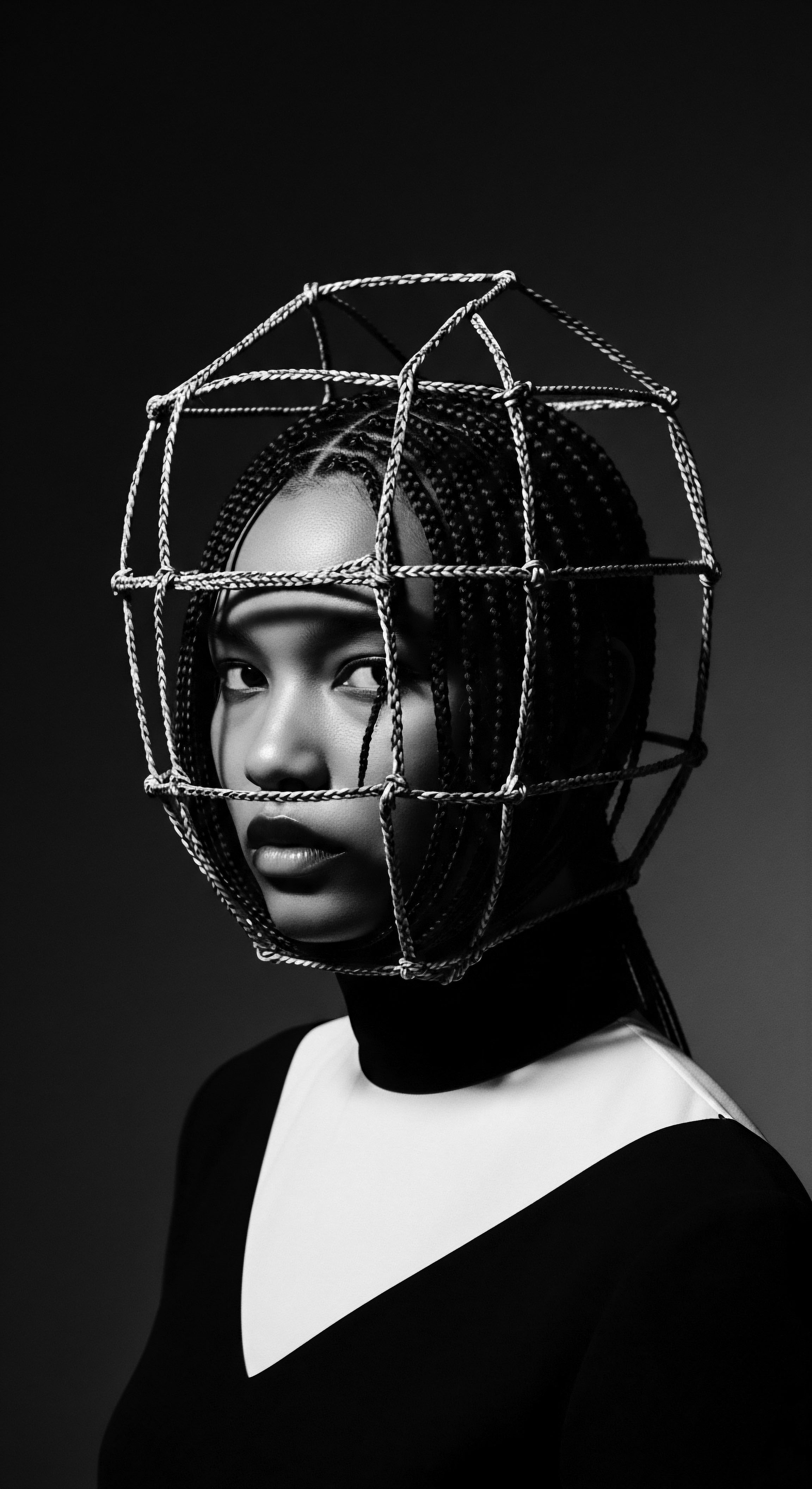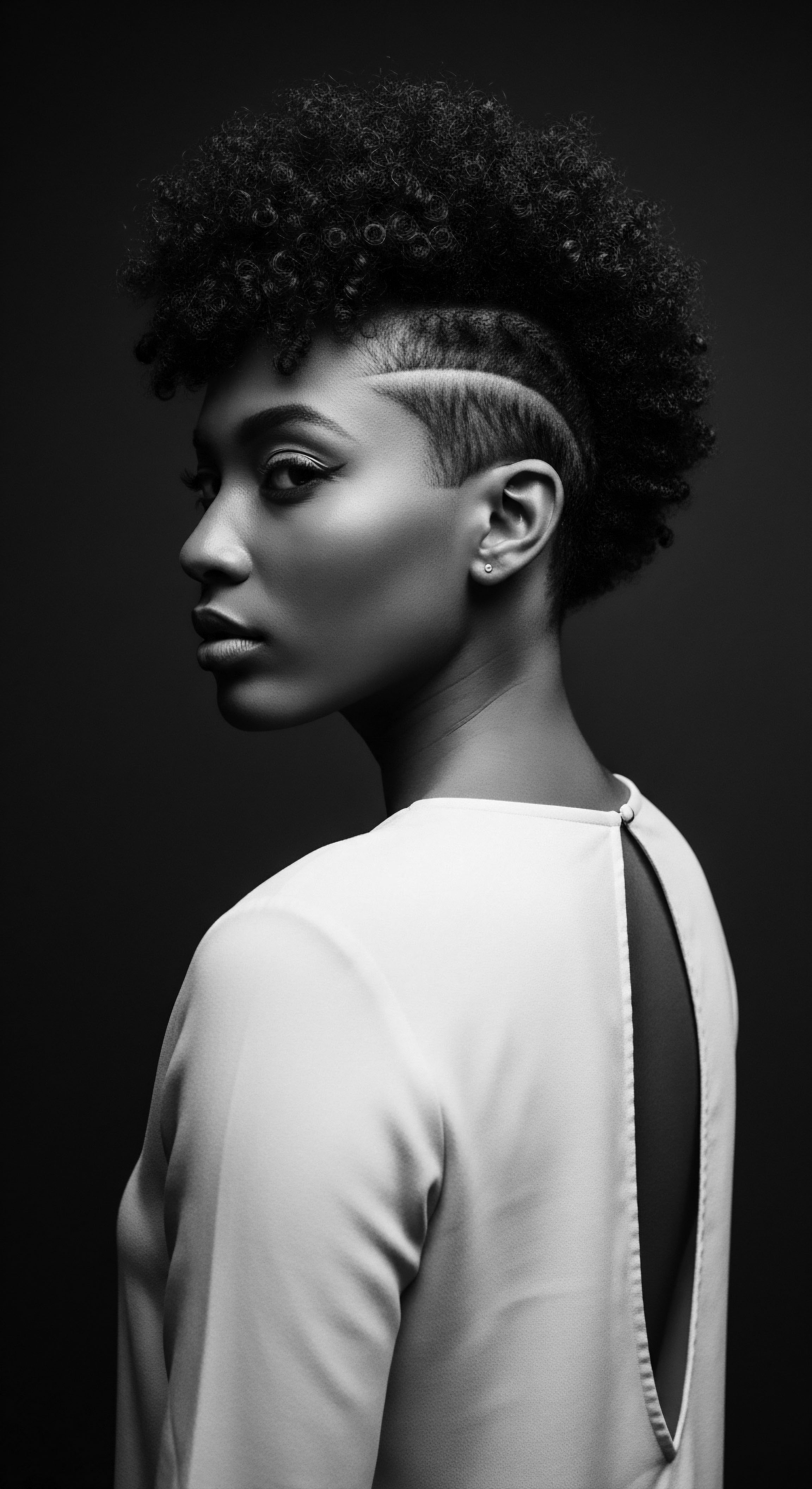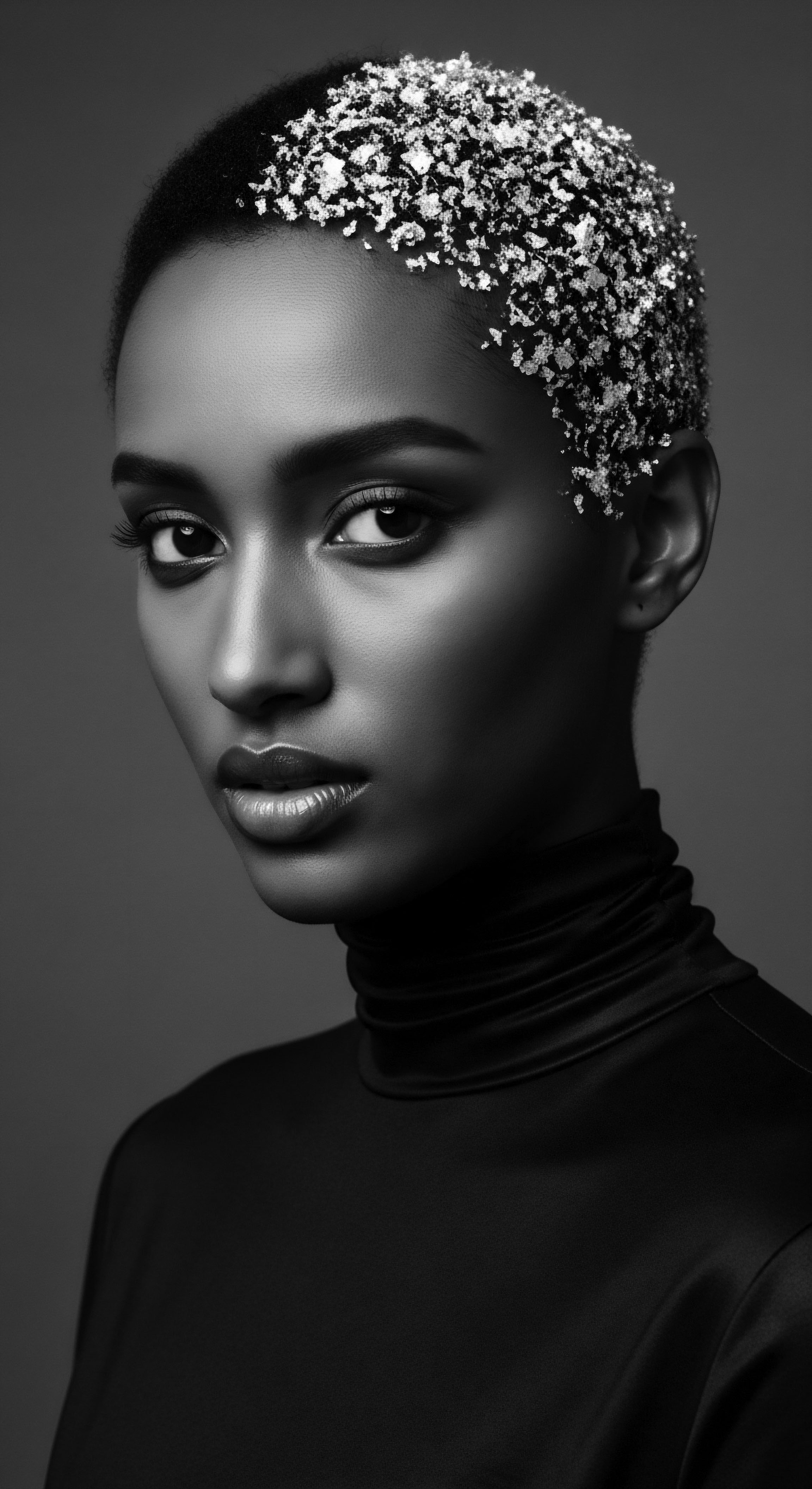
Roots
The stories held within a single strand of textured hair are vast, a lineage stretching back through epochs. Consider the wisdom carried in those coils and kinks, not merely as biological structures, but as living archives of human ingenuity and cultural resilience. From the earliest communal gatherings, the act of tending to hair emerged as more than simple grooming. It became a profound ceremony, a silent language, a sacred thread binding individuals to their ancestors, their communities, and the very spirit of their heritage.
What whispers do these ancient rituals carry, shaping our understanding of identity and belonging even today? The preservation of cultural heritage through these practices for textured hair is a testament to deep knowledge and a soulful connection to the past.
Across ancient civilizations, particularly those in Africa, hair was never a trivial matter. It was a canvas, a communicator, and a symbol imbued with power. The way hair was grown, styled, and adorned spoke volumes about a person’s age, marital status, social standing, religious beliefs, and even their tribal affiliation.
This was especially true for afro-textured hair, with its unique structure and varied curl patterns that lent themselves to an astonishing array of symbolic expressions. The historical journey of afro-textured hair illuminates the complex interplay of biological attributes and sociocultural implications it has sustained through the centuries.

Hair Anatomy and Its Ancestral Echoes
To truly appreciate how ancient hair care rituals preserved cultural heritage, we must consider the hair itself. Textured hair, spanning a spectrum from loose waves to tight coils, possesses a distinct anatomical blueprint. Its elliptical or oval-shaped follicles cause the hair to twist and spiral as it grows, yielding its characteristic curl patterns.
Scientists postulate that afro-textured hair developed as an adaptive response in warmer, sunnier climates, safeguarding the scalp from intense ultraviolet radiation and allowing heat to escape, promoting cooling. This biological design, therefore, is itself a legacy, a testament to ancestral environments.
The ancient peoples, without microscopes or modern chemical analysis, observed and understood the needs of their hair with an intuition that modern science often validates. They recognized the inherent propensity for dryness in tightly coiled strands, the delicate nature of its structure, and its unique requirements for moisture retention. This observational knowledge formed the bedrock of their hair care practices. It was not mere aesthetic pursuit; it was a practical application of ancestral wisdom, ensuring hair health and protecting the scalp in challenging climates.
Ancient hair practices transcended simple aesthetics, embodying generations of learned wisdom about the unique needs of textured hair.

Traditional Hair Lexicon and Classification
The language surrounding textured hair in ancient societies held immense significance. Hair styles and their specific names often conveyed rich cultural data, acting as a non-verbal encyclopedia of heritage. While modern classifications sometimes impose rigid types, ancient communities often understood hair in relation to its meaning within a social context rather than purely by curl pattern.
- Eembuvi ❉ This term denotes the exceptionally long, braided hair worn by the Mbalantu women of Namibia and Angola. It represents not merely a style but a multi-year ritual of hair cultivation and care, marking significant life transitions.
- Cornrows ❉ Known by various names across different regions, these intricate braided patterns trace back to 3000 BC in Africa. They functioned as identifiers for tribal identity, age, marital status, social class, and even, at times, served as maps for escape during periods of oppression.
- Amasunzu ❉ A traditional Rwandan style, distinct for its sculpted, crescent-moon shapes, worn by Hutu and Tutsi populations, often signaling marital status or readiness for battle.
Each term, each style, carried a lineage, a history, a purpose beyond its visual form. The practice of using such specific nomenclature reinforced collective memory and the shared understanding of communal roles and narratives. The precise techniques and meanings associated with these styles were passed down, safeguarding a dynamic cultural language woven into the very strands of existence.
The tools used in these practices also hold deep cultural meaning. For instance, the African comb , often adorned with symbolic motifs, has a history stretching back over 5,500 years, found in archaeological sites like Kush and Kemet (ancient Egypt). These combs were not simply implements for detangling; they were symbols of status, group affiliation, and spiritual beliefs, frequently interred with their owners, affirming hair’s sacred place. The comb itself, then, becomes an artifact of heritage, embodying the care and reverence given to textured hair throughout millennia.

Ritual
Ancient hair care was, at its heart, a ritual. These practices, passed through generations, were not fleeting trends but foundational pillars of daily life and ceremonial passage. They embodied the art and science of textured hair styling, transforming biological strands into powerful statements of cultural identity and continuity.
How did these rituals, precise in their execution and profound in their meaning, shape the very fabric of communal memory and preserve the story of a people? The answers are often found in the techniques, the tools, and the very transformations hair underwent.

Protective Styling Through the Ages
Protective styles, a cornerstone of textured hair care today, possess an ancient lineage deeply embedded in African heritage. These styles, such as braids and twists, were developed not solely for aesthetics but also for practical reasons ❉ to guard the hair from environmental damage, retain length, and signify social status. The longevity of these styles, often requiring hours of communal effort, speaks to their societal value and the knowledge of hair health they embodied.
Consider the Mbalantu women of Namibia, whose tradition involves cultivating remarkably long hair, reaching their ankles. From around the age of twelve, girls begin a ceremonial hair care regimen where their hair is coated with a paste of finely powdered bark from the “Omutyuula” tree mixed with fat. This mixture, reapplied over years, nourishes the hair, prevents breakage, and facilitates its extraordinary growth. The Eembuvi braids , formed from these carefully tended strands, become a visual record of a woman’s journey, changing to reflect her initiation into womanhood and later, her married status.
This example illustrates a powerful interplay ❉ a scientific understanding of hair needs (moisture, reduced manipulation) embedded within a ritual framework that transmits cultural milestones and community values. This practice preserves not only the physical hair but also a living, evolving heritage.
The enduring practices of protective styling reveal an ancient understanding of hair preservation deeply tied to cultural expression.

Natural Styling Techniques and Ancestral Definition
Beyond long-term protective styles, ancient communities also mastered techniques for daily styling and defining natural textured hair. These methods were often inextricably linked to the availability of local botanicals and the prevailing environmental conditions. Hair was shaped and set using methods that honored its natural curl pattern, reflecting an inherent reverence for the hair’s own inclinations.
The application of natural oils and butters was a universal aspect of ancient African hair care. Ingredients such as shea butter, coconut oil, argan oil, and baobab oil were not merely conditioners; they were vital components for moisturizing, protecting, and adding shine to hair. These emollients, rich in essential fatty acids and vitamins, were carefully extracted and prepared, often becoming part of generational recipes. The knowledge of their specific properties and optimal application was a form of ancestral science, safeguarding hair health and allowing for various styling possibilities.
Even cleansing practices were rooted in natural elements. Clay, such as Rhassoul clay from Morocco, was used as a natural cleanser, effectively removing impurities without stripping hair of its vital moisture. This demonstrates a sophisticated understanding of hair’s delicate moisture balance, prioritizing gentle care long before modern chemistry offered synthetic alternatives.
| Ingredient Shea Butter (Vitellaria paradoxa) |
| Ancient Use Moisturizer, sealant, protective barrier for hair and scalp. |
| Cultural Significance Widely used across West Africa; a symbol of women's economic contribution and traditional wellness. |
| Ingredient Moringa Oil (Moringa oleifera) |
| Ancient Use Nourishment, strengthening, adds radiance. |
| Cultural Significance Used for its nutrient density and holistic health properties in many African traditions. |
| Ingredient Omutyuula Bark Paste |
| Ancient Use Promotes extraordinary hair growth, prevents breakage. |
| Cultural Significance Central to the Mbalantu women's coming-of-age rituals and identity. |
| Ingredient African Black Soap |
| Ancient Use Gentle cleansing for hair and scalp. |
| Cultural Significance A traditional West African soap made from plantain skins, cocoa pods, and palm oil, representing a holistic approach to hygiene and care. |
| Ingredient Rhassoul Clay |
| Ancient Use Purifying cleanser, removes buildup without stripping moisture. |
| Cultural Significance A staple in Moroccan beauty rituals, connecting hair care to elemental earth properties. |
| Ingredient These ancient ingredients, passed down through oral traditions, stand as pillars of textured hair heritage, grounding contemporary care in ancestral wisdom. |

The Living Legacy of Wigs and Hair Extensions
Wigs and hair extensions are not modern inventions; their history stretches back to antiquity, particularly in cultures with textured hair. In ancient Egypt, elaborate wigs, often crafted from human hair, wool, or plant fibers, denoted social status, wealth, and religious beliefs. These were not merely decorative elements; they were expressions of identity and societal position. Both men and women adorned them, sometimes intricately braided and embellished with gold or beads.
The continuity of this practice, from ancient Egypt to contemporary protective styles incorporating extensions, underscores the enduring human desire for aesthetic expression and practicality. The methods of attaching hair, whether through braiding or other means, reflect a long-standing knowledge of how to manipulate and extend hair to achieve desired looks while also protecting the natural strands beneath. This legacy also illustrates how ancient rituals transformed hair into a flexible medium for self-expression and cultural communication.

Relay
The deep echoes of ancient hair care rituals reverberate through contemporary practices, forming a relay of wisdom across generations. These ancestral methods for preserving cultural heritage continue to inform holistic care, offering solutions rooted in profound understanding. How, then, do these traditional practices, refined through time and experience, provide a unique lens through which to comprehend the biological complexities of textured hair, all while upholding the spirit of heritage? The answer lies in the careful observation and intuitive application of natural principles.

Building Personalized Regimens From Ancestral Wisdom
The concept of a personalized hair regimen, tailored to individual needs, finds its genesis in ancient practices. Communities understood that while hair shared certain characteristics, unique variations existed. Traditional care was often bespoke, informed by factors like climate, lifestyle, and individual hair responses to natural ingredients. This individualized approach was a form of empirical science, passed down through observation and oral instruction.
For instance, studies in ethnobotany reveal a wealth of plant species used for hair and skin care across Africa. A study in Northeastern Ethiopia identified 17 plant species utilized for hair and skin, with a high informant consensus factor, indicating strong agreement on their uses. Ziziphus spina-christi, for instance, was widely used for its anti-dandruff properties, while Sesamum orientale leaves served for cleansing and styling. (Sharaibi et al.
2024, p. 555845) This collective, validated knowledge allowed for the creation of regimens deeply responsive to both individual and communal needs, drawing from the botanical wealth of their environments.
The knowledge of natural oils and butters for moisturizing textured hair has been a consistent thread across continents. This practical wisdom, emphasizing moisture retention, is a testament to the ancestral understanding of the hair’s inherent needs. The application of plant-based remedies, often formulated with specific intentions—be it for growth, cleansing, or protection—shows a sophisticated understanding of hair biology, even if the underlying cellular mechanisms were not articulated in modern scientific terms.

The Nighttime Sanctuary and Bonnet Wisdom
The practice of protecting hair during sleep, especially for textured hair, is a wisdom that extends far back into history. While the modern satin bonnet or scarf might seem like a recent innovation, the underlying principle of preserving hairstyles and preventing moisture loss or breakage overnight is ancient. Ancestral communities understood the importance of creating a “sanctuary” for hair.
This could involve arranging hair in protective styles, wrapping it with soft cloths, or even sleeping on surfaces that minimized friction. The emphasis on minimizing manipulation and environmental exposure during periods of rest points to an early understanding of hair fragility and the mechanisms of breakage. Such routines were not merely about maintaining beauty; they were about preserving the integrity of styles that often communicated vital social information and represented hours of communal effort. The bonnet, in its essence, represents a continuum of this ancestral practice, safeguarding the health and longevity of textured strands.

Ingredient Ancestry for Textured Hair Needs
The ingredients central to ancient hair care were overwhelmingly natural, drawn directly from the surrounding ecosystem. The efficacy of these traditional components is now increasingly affirmed by modern scientific inquiry.
- Shea Butter ❉ A staple in West African communities, shea butter continues its legacy as a powerful emollient, rich in vitamins A and E, and essential fatty acids. Its use in ancient times provided deep moisture and a protective seal, preventing dryness and breakage.
- Baobab Oil ❉ Extracted from the “Tree of Life,” baobab oil, revered for its lightweight nature, offered ancient peoples a means to restore shine and nourish hair without weighing it down. It contains vitamins and fatty acids that aid in skin and hair vitality.
- African Black Soap ❉ Traditionally made from plantain skins, cocoa pods, and palm oil, this gentle cleanser from West Africa cleanses the scalp and hair without stripping natural oils, a balance critical for textured hair.
- Moringa Oil ❉ A nutrient-dense oil from the moringa tree, used historically for its nourishing and restorative properties for both hair and skin, showcasing a holistic approach to wellness.
These ingredients were not chosen arbitrarily. Their consistent use over centuries speaks to their observed effectiveness, passed down through generations of practitioners who understood the symbiotic relationship between nature and human well-being.

Holistic Influences on Hair Health From the Past
Ancient hair care was seldom a standalone practice. It was deeply integrated into a holistic philosophy of well-being, recognizing the interconnectedness of body, mind, and spirit. The health of hair was often seen as a reflection of overall vitality. This perspective meant that hair rituals sometimes involved dietary considerations, spiritual practices, or communal gatherings that reinforced social bonds.
The communal act of hair braiding, for example, was more than a styling session. It served as a vital social ritual, a space for sharing stories, wisdom, and strengthening intergenerational connections. Mothers, sisters, and elders would share knowledge, creating an environment where cultural norms, historical narratives, and practical skills were transmitted.
This shared experience solidified identity and reinforced a sense of belonging, making hair care a living archive of community and heritage. The very act of tending to one another’s hair built and preserved a collective heritage, strand by painstaking strand.

Reflection
As we gaze upon the intricate patterns of textured hair today, we witness a legacy that defies the erosion of time and the forces of cultural erasure. The ancient hair care rituals, far from being relics of a forgotten past, are living testimonies to the resilience, creativity, and profound wisdom of ancestral communities. They speak to a time when hair was not merely an aesthetic choice but a potent medium for expressing identity, transmitting history, and solidifying social structures. The soul of a strand, indeed, holds within its helix the whispers of generations who understood hair as a sacred extension of self and community.
The journey through these rituals unveils a continuum of knowledge, from the anatomical understanding of textured hair’s unique thirst for moisture to the strategic ingenuity behind protective styles. The Mbalantu women, with their ankle-length eembuvi braids, stand as a luminous example of how sustained ancestral practices preserve not just a physical trait, but an entire cultural narrative, woven into every strand and every ceremonial step. Their enduring tradition serves as a vibrant reminder that hair care, at its core, can be an act of profound self-preservation and cultural affirmation.
This historical exploration encourages us to approach our own hair care with a renewed sense of purpose, recognizing the deep currents of heritage that flow through our daily routines. To honor textured hair is to honor a living archive, a story of resistance, adaptation, and beauty that has defied attempts to diminish its significance. Each coil, each kink, each carefully chosen ingredient carries forward a legacy, inviting us to connect with the ancestral wisdom that shaped our understanding of hair as a profound source of identity and belonging. The past reaches into the present, ensuring that the vibrancy of our hair continues to speak volumes about who we are and from whom we descend.

References
- Byrd, A. & Tharps, L. (2001). Hair Story ❉ Untangling the Roots of Black Hair in America. St. Martin’s Press.
- Chimbiri, K. N. (2021). The Story of Afro Hair. Scholastic.
- Dabiri, E. (2019). Twisted ❉ The Tangled History of Black Hair Culture. HarperCollins.
- Leitao, D. (2003). Adolescent Hair-Growing and Hair-Cutting Rituals in Ancient Greece ❉ A Sociological Approach. In D. Dodd & C. A. Faraone (Eds.), Initiation in Ancient Greek Rituals and Narratives ❉ New Critical Perspectives. Routledge.
- Marshall, A. (2025). The magic and power of hair in ancient Egypt. Ancient Egypt, (147).
- Marshall, L. M. (2023). A historical journey of the structure, texture, and identity of afro-textured hair. British Journal of Dermatology, 189(S1), ho4.
- Sharaibi, O. J. Oluwa, O. K. Omolokun, K. T. Ogbe, A. A. & Adebayo, O. A. (2024). Cosmetic Ethnobotany Used by Tribal Women in Epe Communities of Lagos State, Nigeria. Journal of Complementary Medicine & Alternative Healthcare, 12(4), 555845.
- Springfield, S. A. (2021). Heavy is the Head ❉ Evolution of African Hair in America from the 17th c. to the 20th c. (Master’s thesis). Library of Congress.
- Tulloch, C. (2014). Radical Objects ❉ The Black Fist Afro Comb. History Workshop Journal, 77(1), 226-237.
